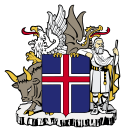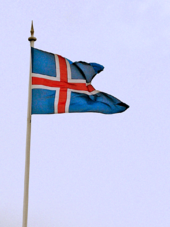Politics of Iceland
| Iceland |
 This article is part of the series: |
|
|
|
Constitution
Institutions
Elections
Divisions
Foreign Affairs
|
|
Other countries · Atlas |
Politics of Iceland takes place in a framework of a parliamentary representative democratic republic, whereby the Prime Minister of Iceland is the head of government, and of a multi-party system. Executive power is exercised by the government. Legislative power is vested in both the government and parliament, the Althing. The Judiciary is independent of the executive and the legislature.
Contents |
Political developments
In losing four seats in the April 1995 parliamentary elections, the IP and SDP mustered a simple majority in the 63-seat Althing. However, Prime Minister and IP leader Davíð Oddsson chose the resurgent Progressive Party as a more conservative partner to form a stronger and more stable majority with 40 seats. Splintered by factionalism over the economy and Iceland's role in the European Union (EU), the SDP also suffered from being the only party to support Iceland's EU membership application.
Executive branch
| Office | Name | Party | Since |
|---|---|---|---|
| President | Ólafur Ragnar Grímsson | n/a | 1 August 1996 |
| Prime Minister | Geir Haarde | (D) | 5 June 2006 |
The president, elected to a 4-year term, has limited powers. The prime minister and cabinet exercise most executive functions. The president of Iceland is a largely ceremonial office that serves as a diplomat, figurehead and head of state. The head of government is the prime minister, who, together with the cabinet, takes care of the executive part of government. The cabinet is appointed by the president after general elections to Althing; however, this process is usually conducted by the leaders of the political parties, who decide among themselves after discussions which parties can form the cabinet and how its seats are to be distributed (under the condition that it has a majority support in Althing). Only when the party leaders are unable to reach a conclusion by themselves in reasonable time does the president exercise this power and appoint the cabinet himself. This has never happened since the republic was founded in 1944, but in 1942 the regent of the country (Sveinn Björnsson, who had been installed in that position by the Althing in 1941) did appoint a non-parliamentary government. The regent had, for all practical purposes, the position of a president, and Björnsson in fact became the country's first president in 1944. The governments of Iceland have almost always been coalitions with two or more parties involved, because no single political party has received a majority of seats in Althing in the republic period. The extent of the political powers possessed by the office of the president are disputed by legal scholars in Iceland; several provisions of the constitution appear to give the president some important powers but other provisions and traditions suggest differently. The president is elected every four years (last 2004), the cabinet is elected every four years (last 2007) and town council elections are held every four years (last 2006).
Legislative branch
The modern parliament, called "Althing" or "Alþingi", was founded in 1845 as an advisory body to the Danish king. It was widely seen as a reestablishment of the assembly founded in 930 in the Commonwealth period and suspended in 1799. The Althing is composed of 63 members, elected every 4 years unless it is dissolved sooner. Suffrage for presidential and parliamentary elections is 18 years of age and is universal. Members of the Althing are elected on the basis of proportional representation from six constituencies. Until 1991, membership of the Althing was divided between a lower and upper house but this was changed to a fully unicameral system.
Political parties and elections
After four 4-year terms as the world's first elected woman president, the widely popular Vigdís Finnbogadóttir chose not to run for re-election in 1996. More than 86% of voters turned out in the June 29, 1996 presidential elections to give former leftist party chairman Ólafur Ragnar Grímsson a 41% plurality and relatively comfortable 12% victory margin over the closest of three other candidates. Traditionally limited to 6-12 weeks, Iceland's campaign season was marked by several intensely personal attacks on Grímsson, a former finance minister who tried to erase memories of his controversial support of inflationary policies and opposition to the U.S. military presence at the NATO base in Keflavík. Grímsson successfully has used his largely ceremonial office to promote Icelandic trade abroad and family values at home.
| Candidates | Votes | % |
|---|---|---|
| Ólafur Ragnar Grímsson | 90,662 | 85.6 |
| Baldur Ágústsson | 13,250 | 12.3 |
| Ástþór Magnússon | 2,001 | 1.9 |
| Total valid votes (turnout 63.0%) | 105,913 | 100.0 |
| Empty ballots | 27,627 | 23.3% |
| Void votes | 834 | |
| Source: ruv.is | ||
The next presidential elections are scheduled in May or June 2008.
The last parliamentary elections took place on May 12, 2007. The ruling coalition parties, the Independence Party and the Progressive Party lost four seats in Alþingi but nevertheless still hold a slim majority hold 32 seats, a 1 seat majority in the 63 seat Alþingi. But Independence Party and Progressive Party have split up after 12 years together. Independence Party formed a new coalition with Social Democratic Alliance under Haarde, a coalition holding 43 seats, a 20 seat majority in the 63 Seat Alþingi. A total of 185.392 votes were cast constituting 83.6% of 221.368 the electorate. The results of the 2007 election were as follows (changes in seat distribution indicated in brackets):
| Parties | Votes | % | +/–% | Seats | +/– | |
|---|---|---|---|---|---|---|
| Independence Party (Sjálfstæðisflokkurinn) | 66,749 | 36.6 | +2.9 | 25 | +3 | |
| Social Democratic Alliance (Samfylkingin) | 48,742 | 26.8 | –2.4 | 18 | –2 | |
| Left-Green Movement (Vinstrihreyfingin - grænt framboð) | 26,136 | 14.3 | +5.5 | 9 | +4 | |
| Progressive Party (Framsóknarflokkurinn) | 21,349 | 11.7 | –6.0 | 7 | –5 | |
| Liberal Party (Frjálslyndi flokkurinn) | 13,233 | 7.3 | –0.1 | 4 | ±0 | |
| Iceland's Movement – Living Land (Íslandshreyfingin - lifandi land) | 5,953 | 3.3 | +3.3 | — | — | |
| Total (turnout 83.6%) | 182,679 | 100 | 63 | |||
| Source: http://www.mbl.is/mm/frettir/kosningar/ | ||||||
The next parliamentary elections are scheduled in May 2011.
Judicial branch
The judiciary consists of the Supreme Court or Hæstiréttur, justices are appointed for life by the president, and district courts. The constitution protects the judiciary from infringement by the other two branches.
Administrative divisions
Iceland is divided in 23 counties (sýslur, singular sýsla) and 14 independent towns* (kaupstaðir, singular kaupstaður); Akranes*, Akureyri*, Árnessýsla, Austur-Barðastrandarsýsla, Austur-Húnavatnssýsla, Austur-Skaftafellssýsla, Borgarfjarðarsýsla, Dalasýsla, Eyjafjarðarsýsla, Gullbringusýsla, Hafnarfjörður*, Húsavík*, Ísafjörður*, Keflavík*, Kjósarsýsla, Kópavogur*, Mýrasýsla, Neskaupstaður*, Norður-Ísafjarðarsýsla, Norður-Múlasýsla, Norður-Þingeyjarsýsla, Ólafsfjörður*, Rangárvallasýsla, Reykjavík*, Sauðárkrókur*, Seyðisfjörður*, Siglufjörður*, Skagafjarðarsýsla, Snæfellsnes- og Hnappadalssýsla, Strandasýsla, Suður-Múlasýsla, Suður-Þingeyjarsýsla, Vestmannaeyjar*, Vestur-Barðastrandarsýsla, Vestur-Húnavatnssýsla, Vestur-Ísafjarðarsýsla, Vestur-Skaftafellssýsla
Current ministers
- Prime Minister: Geir H. Haarde (D)
- Minister of Social Affairs: Jóhanna Sigurðardóttir (S)
- Minister of Finance: Árni M. Mathiesen (D)
- Minister of Justice: Björn Bjarnason (D)
- Minister of Fisheries and Agriculture : Einar Kristinn Guðfinnsson (D)
- Minister of Foreign Affairs: Ingibjörg Sólrún Gísladóttir (S)
- Minister of Health: Guðlaugur Þór Þórðarson (D)
- Minister of the Environment: Þórunn Sveinbjarnardóttir (S)
- Minister of Transportation affairs: Kristján Möller (S)
- Minister of Manufacturing Industries: Össur Skarphéðinsson (S)
- Minister of Trade: Björgvin G. Sigurðsson (S)
- Minister of Culture and Education: Þorgerður Katrín Gunnarsdóttir (D)
International organization participation
Arctic Council, Australia Group, BIS, CBSS, CE, EAPC, EBRD, ECE, EFTA, FAO, IAEA, IBRD, ICAO, ICCt, ICC, ICRM, IDA, IEA (observer), IFC, IFRCS, IHO, ILO, IMF, IMO, Inmarsat, Intelsat, Interpol, IOC, ISO, ITU, ITUC, NATO, NC, NEA, NIB, OECD, OPCW, OSCE, PCA, UN, UNCTAD, UNESCO, UNMIK, UNU, UPU, WCO, WEU (associate), WHO, WIPO, WMO, WTrO
|
||||||||||||||||||||||||||||||||
|
|||||||||||
